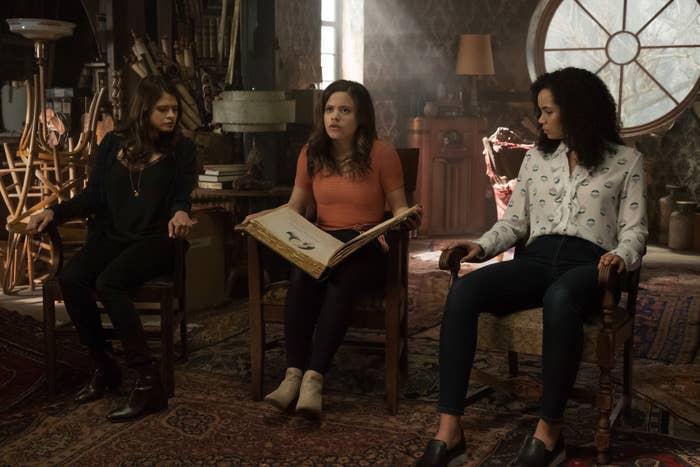
Nothing fictional ever really dies. Not everyone is a fan of the reboot, but given that even ALF is coming back, it’s a reality we all have to face. Whether you like it or not, Roswell, Gilmore Girls, Ghostbusters, Bug Juice, DuckTales, Dynasty, Fear Factor, Miami Vice, The Magic School Bus, Will & Grace, Roseanne, Murphy Brown, and even Buffy the Vampire Slayer have all gotten — or are about to get — the reboot or revival treatment. And the CW’s new take on Charmed, which premieres Oct. 14, is already fighting a hard battle, embroiled in backlash before it’s even premiered.
The original Charmed was one of the rare shows in the ‘00s that was centered on not one woman but three, and for eight seasons, it championed the full and nuanced humanity of all of them. It was a landmark show, and it remains one worth revisiting even 20 years after it premiered. The series, created by Constance M. Burge, ran from 1998 to 2006 and starred a rotating quartet of talent in Alyssa Milano, Holly Marie Combs, Shannen Doherty, and Rose McGowan. They played the Halliwell sisters, who live in an inherited, witchy manor in San Francisco and, in the show’s pilot, discover that they are the most powerful sister witches in the world.

This time around, Charmed is being resurrected by CBS Studios, Jane the Virgin creator Jennie Urman, and Jane the Virgin producers Jessica O’Toole and Amy Rardin, who will be showrunners for the series. But despite this strong pedigree, Charmed is already embattled, with Milano, Combs, and Doherty — who did their own producing work on the original series — expressing their displeasure with aspects of the reboot. Milano tweeted that the reboot was happening too soon after the original, Combs took the new series as a sign that the studio thought that the original actors were too old for their roles, and Doherty didn’t like that the 2018 Charmed was being labeled a “feminist” reboot, interpreting that as a dig at the original not being feminist enough. Combs also tweeted about the behind-the-scenes work some of the cast did on the original show. “Until you ask us to rewrite it like Brad Kern did weekly don’t even think of capitalizing on our hard work,” she wrote. “Charmed belongs to the 4 of us, our vast amount of writers, crews and predominantly the fans. FYI you will not fool them by owning a title/stamp. So bye.” Since the reboot was confirmed, hordes of fans on Twitter have been sliding into the mentions of any member of the cast, crew, and media who brings up the new series. McGowan, for her part, was initially hesitant about the reboot but has since reversed her position, showing her support for the new Charmed and its cast.
So what is actually up with the rebooted Charmed? What is this new show setting out to be, and how is it going to address the weight of the Charmed legacy? Here’s what you need to know about the series going into the first season, and how the reboot’s trying its damnedest to honor the source material while simultaneously dragging it into 2018.
The show changed course in a major way after the 2016 presidential election.
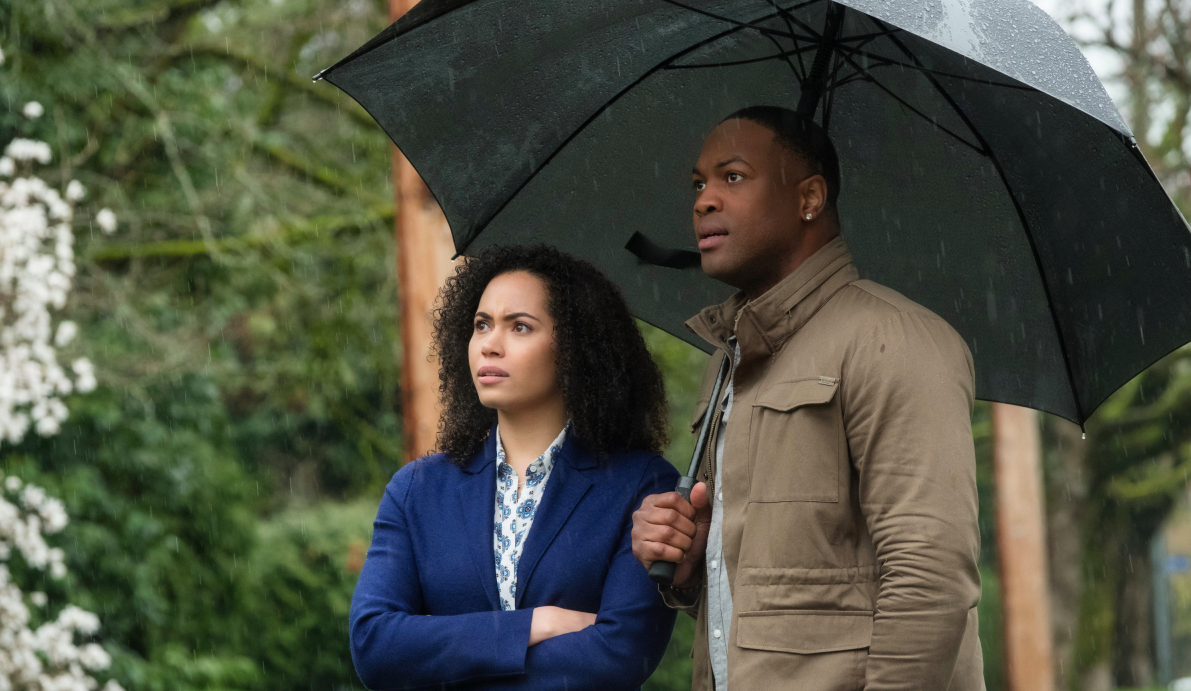
A Charmed reboot of some sort has been in the works since at least 2013. According to early reports, Sydney Sidner and Party of Five creator Chris Keyser were signed on to write the pilot. Eventually, that fell through, and CBS approached Urman about bringing Charmed back to life. Urman, knowing that O’Toole and Rardin were fans of the original series, brought them onboard with her. The new Charmed was originally planned as a prequel that O’Toole said would have been set in the 1970s and “explicitly explore[d] the links between the feminist movement and witchcraft.” That designation is what irked Doherty, who saw it as a slight against her Charmed.

It’s worth noting, though, that the producers on the Charmed reboot do acknowledge the progressive attitudes of the original. It was never about discounting the messages of the first Charmed. Though it has changed shape and since abandoned the prequel idea, every iteration of the reboot has simply set out to draw the connections between the feminist movement and witchcraft even more explicitly than the original did, with one of the central characters literally being a women’s rights activist. The original Charmed was “ahead of its time,” as O’Toole put it. “[Feminism] was treated as a dirty word back then, people weren’t using it as a buzzword to associate with their show,” O’Toole said. “But now we’re all realizing that we need to be.”
The producers also put the reboot through an overhaul after the 2016 election. “Suddenly it didn’t feel like it should be a period piece anymore,” O’Toole told BuzzFeed News. “All of the themes seemed more relevant, and we wanted to reconceptualize some things, and it felt like it really should be set in a contemporary world.” She said that the decision to bring the series into modern times “really opened the show up.” But moving up the timeline might also be what put the new Charmed in the line of fire for fans of its predecessor. Bringing the characters into 2018 means they exist in a time after the events of the original series — as opposed to being safely ensconced in a past era where the Halliwells were infants. If the Halliwells could exist as adults in this universe, it begs the question of why they’re not the stars of this series.
The reckoning will play a big role in the show’s first season.

As O’Toole said, mimicking a line that’s in the pilot, “witchcraft and strong women have always been connected.” But when the show moved to modern times, so did the context of its conversations. The pilot introduces us to a plot heavily influenced by #MeToo, Time’s Up, and the reckoning that brought so many people’s stories of sexual abuse to light this past year. The show is partly set on a college campus, and the sisters are all tangentially connected to an ongoing case of campus sexual harassment and assault that has left a girl in a coma. It’s a thread that the pilot promises to follow throughout the show’s first season. There are also references to prolific Bad Feminist author Roxane Gay’s Twitter account, a running gag about the importance of teaching people consent, and a calling-out of everyone who’s ever dismissed the pursuit of justice against sexual predators as a “witch hunt.”
“It’s not like every demon on the show is a sexual predator,” O’Toole noted, “but we want always to reflect real-world themes that play into these women’s lives.” Given how massive the #MeToo movement has become, and how much has changed around the concept of “girl power” since the original Charmed was on the air, the choice to lead with the beginnings of an in-show reckoning feels fitting.
The majority of the main cast are people of color, and one of the sisters is queer.
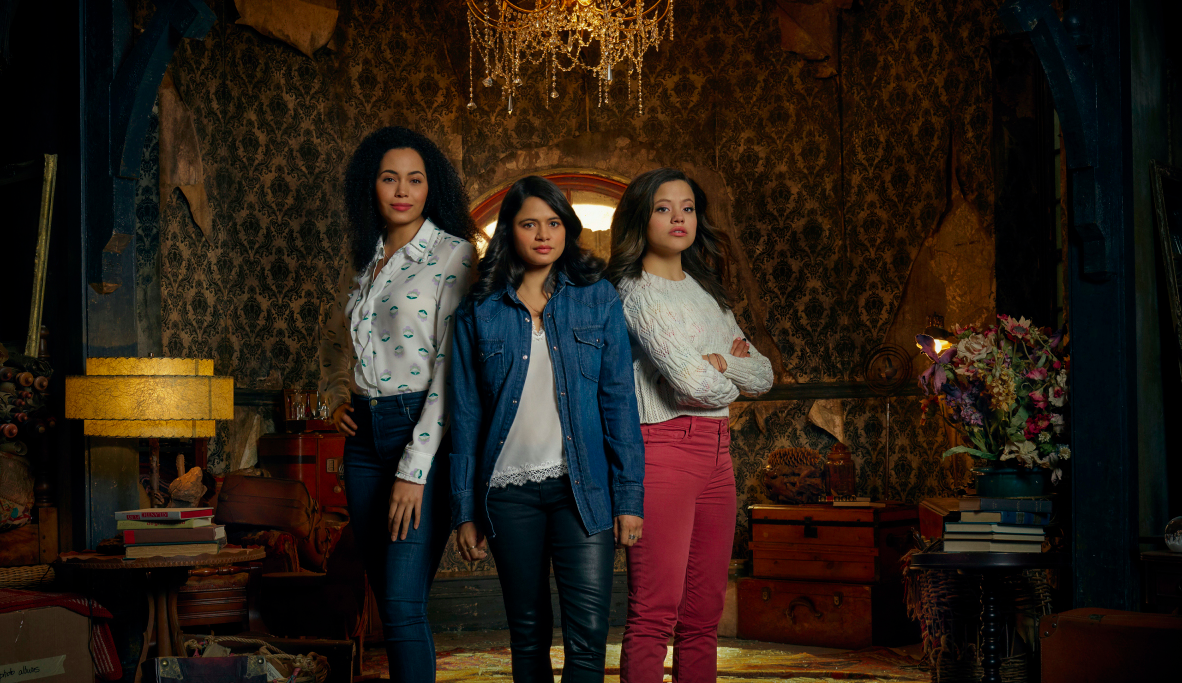
Core to the producers’ vision of the new Charmed was a multiracial trio. This time around, the series centers on three Latina sisters, played by Madeleine Mantock, Melonie Diaz, and Sarah Jeffery. Mantock, who plays long-lost sister Macy Vaughn, is Afro-Caribbean. In the pilot, Vera matriarch Marisol Vera dies; a few months later, Macy moves to town and discovers that Marisol was her mother and that Marisol’s daughters, Mel and Maggie, are her sisters. It’s the inciting incident that leads to the trio getting their powers and discovering their status as witches.
“It was always written that way, specifically to have characters who were of color."
“It was always written that way, specifically to have characters who were of color, and with the casting it all kind of came together,” O’Toole said. She also noted that their desire to make the main cast all nonwhite is one of the major reasons they decided the show wouldn’t be based around the Halliwell sisters’ children. As great as the original show’s Halliwell kids were, they were all white — as was the vast majority of the cast.
Mantock stresses that the Charmed reboot is a new entity, in part because it’s anchored by a cast of mainly people of color. She told BuzzFeed News about a person in the audience of the show’s San Diego Comic-Con panel whose young cousin had been excited to see that Mantock had the same hair pattern she did. “I didn’t really have anyone like that [growing up] where you could see yourself on TV,” Mantock said. “And not in a vain way, but to have that representation and be able to see people who look like you living life means something. There’s a hole, there’s something missing when you don’t have that.”
For the producers, inclusion was essential both onscreen and behind the scenes. “Most of our characters are people of color, and it’s important to have that reflected in your staff,” O’Toole said. “Writing is a team sport on a TV show, so having those voices and making sure that they feel heard and empowered to point out blind spots, that’s something we always announce openly. It’s the real world. It’s weird that Hollywood is whiter than the rest of the world.”
In just 6 weeks, upon being detained at the border, 1,995 children have been separated from their families, and now a tent city has cropped up in Texas built to detain immigrant children. We have to do something. #KeepFamiliesTogether #EndFamilySeparation https://t.co/EC6wHUv4dx
One of the sisters, Mel (Diaz), is also queer and a passionate activist for women’s rights. The pilot highlights her relationship with a local detective, Nico (Ellen Tamaki). Diaz was skeptical of both the reboot and her place in it when she was first approached to audition for the show, but she was pleasantly surprised in her first meeting with Urman and the rest of the producers. “I was like, ‘do they want me to play the best friend or something? What’s happening?’” But that wasn’t the case — they wanted Diaz to be one of the leads. She ended up being the first sister they cast.
“We want to try to normalize that people like us can still be the hero of the story,” Mantock said.
Diaz, too, is passionate about the importance of the show being anchored by women of color. “We’re in a time where so much change is needed, and there’s so much race-baiting, and ugliness, and defensiveness,” she said. “We just want to create a show where it’s all-inclusive and everybody sees a little bit of themselves.”
"I just hope that we can introduce other characters so there’s not just one type, not just one shade, because we’re all a little bit beige.”
Mantock also noted a desire to continue that commitment to representation: She’s already spoken with the producers about getting a wider variety of skin colors on the show, since colorism is rampant in Hollywood and beyond. “I’ve said that if we ever introduce my family, I’d like to have people who have darker skin than me,” Mantock said. “It’s something I’m conscious of, because I recognize my privilege, and a lot of people don’t get to be the lead of a show. I just hope that we can introduce other characters so there’s not just one type, not just one shade, because we’re all a little bit beige.”
The new Charmed is setting out to be an updated, more intersectional version of the original. “The foundation that they laid was so important, because they were three female leads, which was so progressive for that time,” Jeffrey said. “And we’re taking that, and appreciating that, but also adding the representation for people of color aspect.”
The mythology of the world will play heavily off of the original.
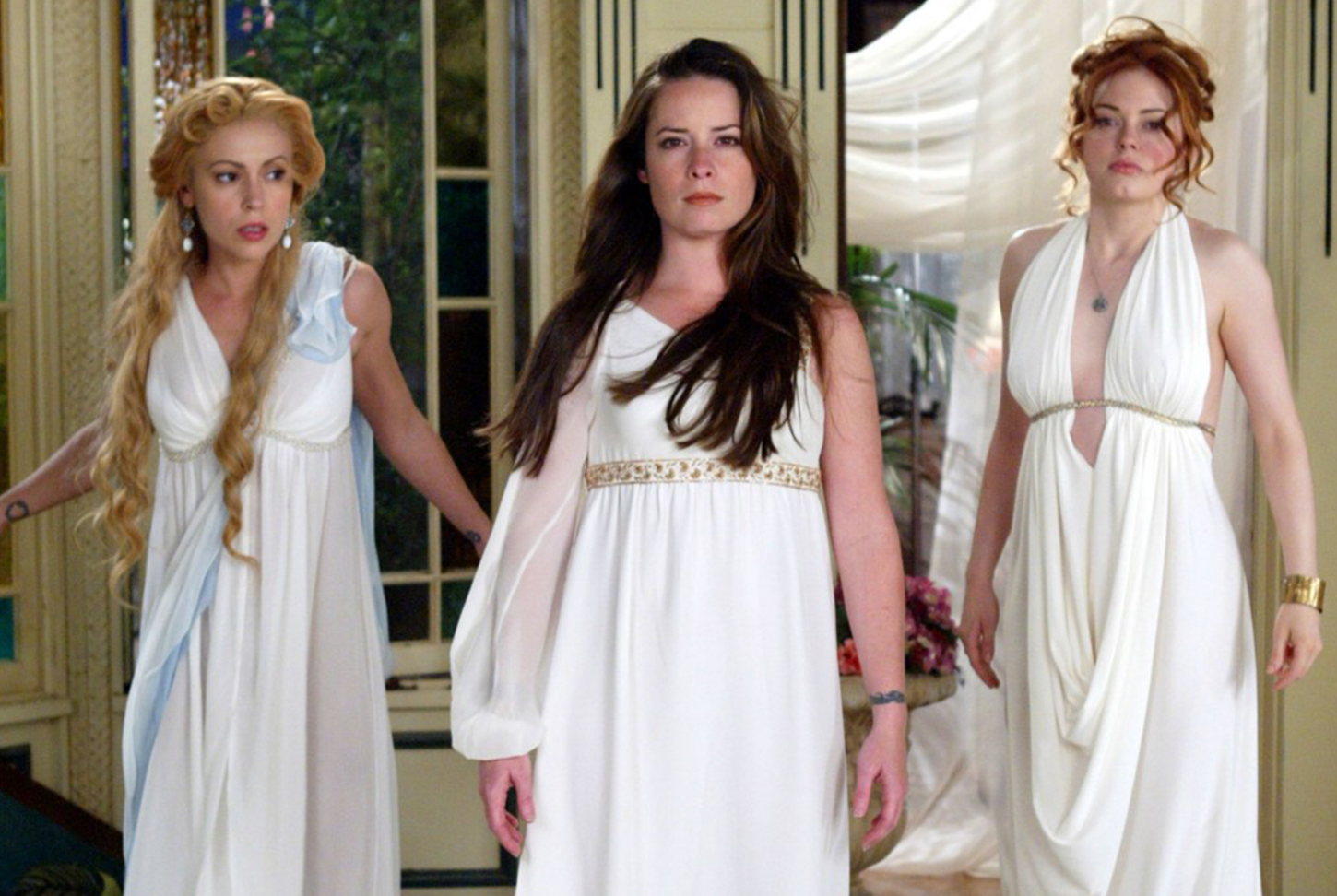
Rest assured, much of the world-building of the original Charmed is alive in the new one. In the pilot episode, the sisters meet Harry Greenwood (Rupert Evans), their Whitelighter. He hands them their Book of Shadows, the book that collects magical knowledge through the generations. “We use a lot of the basic mythology,” O’Toole said. “We have different ways that we interpret it, but the essentials of the hierarchy are the same.” That includes Elders and the Source of All Evil, both of which caused a lot of trouble for the characters in the original series. But it’s important to note that the sisters’ relationships with these forces will likely be different in the update. The pilot doesn’t set up any Piper-and-Leo–style romances between a Whitelighter and a charge, for example, though it’s got a lot of other things going on romantically.
As for the sisters’ powers, the fundamentals of the original stand, sometimes with slight twists. The youngest sister, Maggie (Jeffery), has psychological powers reminiscent of Phoebe’s in the original — but Maggie doesn’t have premonitions yet. Instead, she reads minds. The middle sister, Mel, learns in the pilot she can freeze time; the eldest, Macy, can move objects with her mind. Macy is also a scientist and is invested in figuring out the connections between science and magic. And the writers have plans to make use of the source material’s deep bank of demons and other antagonistic forces. “We’re all familiar with and have been studying all of their demons,” O’Toole said. “They have so many demons.”
Though it’s still up in the air how and where the Halliwells fall into the equation.

For any fan of the original Charmed, one of the most notable parts of the reboot’s pilot comes when the sisters are leafing through the Book of Shadows for the first time. It’s then that we get a flash of a portrait and a very important name: Melinda Warren, the first witch in the Halliwell line, the matriarch of it all, who was burned at the stake in Salem, but passed her powers on to all her descendants. There’s no word yet on how exactly she connects to the Vera family, but the cameo does establish something very important: There is a connection between the Halliwells and the Veras.
O’Toole said that while they’re trying to give the original main cast their space after their objections, “it’d be great if we could get them involved at some point.” She noted that any Halliwell contact might have to come via some sort of parallel universe situation — the mythology of the original show establishes that there’s only one set of Charmed ones, so it’s unlikely the events of the original series occurred in the reboot’s world. Luckily for the writers, multiple universes are easy to get away with on a magical show — the Halliwells themselves did a lot of parallel universe hopping in their day. O’Toole mentioned that the producers would gladly welcome any cast members from the original on the reboot, particularly shouting out her appreciation of Cole (Julian McMahon). She said that one of the bonuses of a parallel universe is that characters who died in the original could be alive in the new, Vera-centric universe. That could mean former major characters like Cole, a dead Halliwell sister like Doherty’s Prue, or even more tertiary characters from the original series.
But there’s one thing O’Toole is very cautious about when it comes to approaching how the worlds of the two series connect: She doesn’t want to ruin any of the happy endings the original show gave its characters. “I always hate when [characters] get a happy ending and then [writers] change that in a later [iteration],” she said.
The people behind the show understand the backlash, but it’s still a bummer.
If you’re gonna quote me then actually quote me @yahoo.
“It does make sense,” Jeffery said. “It’s so dear to them, and I get it.” All the members of the cast and creative team who talked to BuzzFeed News noted that they’re hoping people will at least give the show a chance. “We’re trying our best to be really respectful of the legacy while doing something new,” O’Toole said. Many fans still find that hard to believe, especially given the public rebukes by original cast members. Some of those maligning the new Charmed just don’t want the original disrespected, or don’t see the point of reboots at all. Others are approaching their displeasure in a more coded — or sometimes outright — racist manner, objecting specifically to the new show’s casting.
"It makes sense that youd like Charmed Compton" is a wild (and racist!) way to respond to someone liking a tv show!
“I think these people who are really prejudiced about it aren’t being open to what we have to show,” Diaz said. “And I get it, [Charmed] is a big part of their identity, but we’re not trying to take that from you, we just want to take it in a different direction.” She also said that it’s OK if they don’t win over everyone, but the screening at Comic-Con, where they showed the pilot to the public for the first time, was a good opportunity to see how people reacted to the actual show itself, as opposed to just the concept of a Charmed reboot.
“After the screening it felt like we had a chance,” Diaz said. “We have a fucking chance.”
Jeffery agreed: “We did see some shift after the panel. A lot of people online were like, ‘OK, I get it.’ And that’s fun.” Listening to the reaction in the room at Comic-Con that day, you could literally hear the audience warm up to the show in real time.
There are also plenty of people who have been excited for the reboot since the cast was announced, after they learned that the sisters who will be saving the world this time around are Latina and that one of the sisters is queer.
I wish everyone the best. I have zero reboot issues. Fly, girls, fly. .@Refinery29 #Charmed https://t.co/s2WGSkQXJC
Mantock also mentioned her appreciation of McGowan’s decision to tweet in support of the new show and cast. “I just thought that was so kind of her,” Mantock said. McGowan has been the only one of the original cast of sisters to support the reboot. She also posted to her Instagram about the show Aug. 1, writing, “Is the reboot really that bad? I hope not— I wish nothing but the best for the new female actors whose careers hopefully will be launched by this show into something long and prosperous.”
The show also has deep roots in Jane the Virgin.
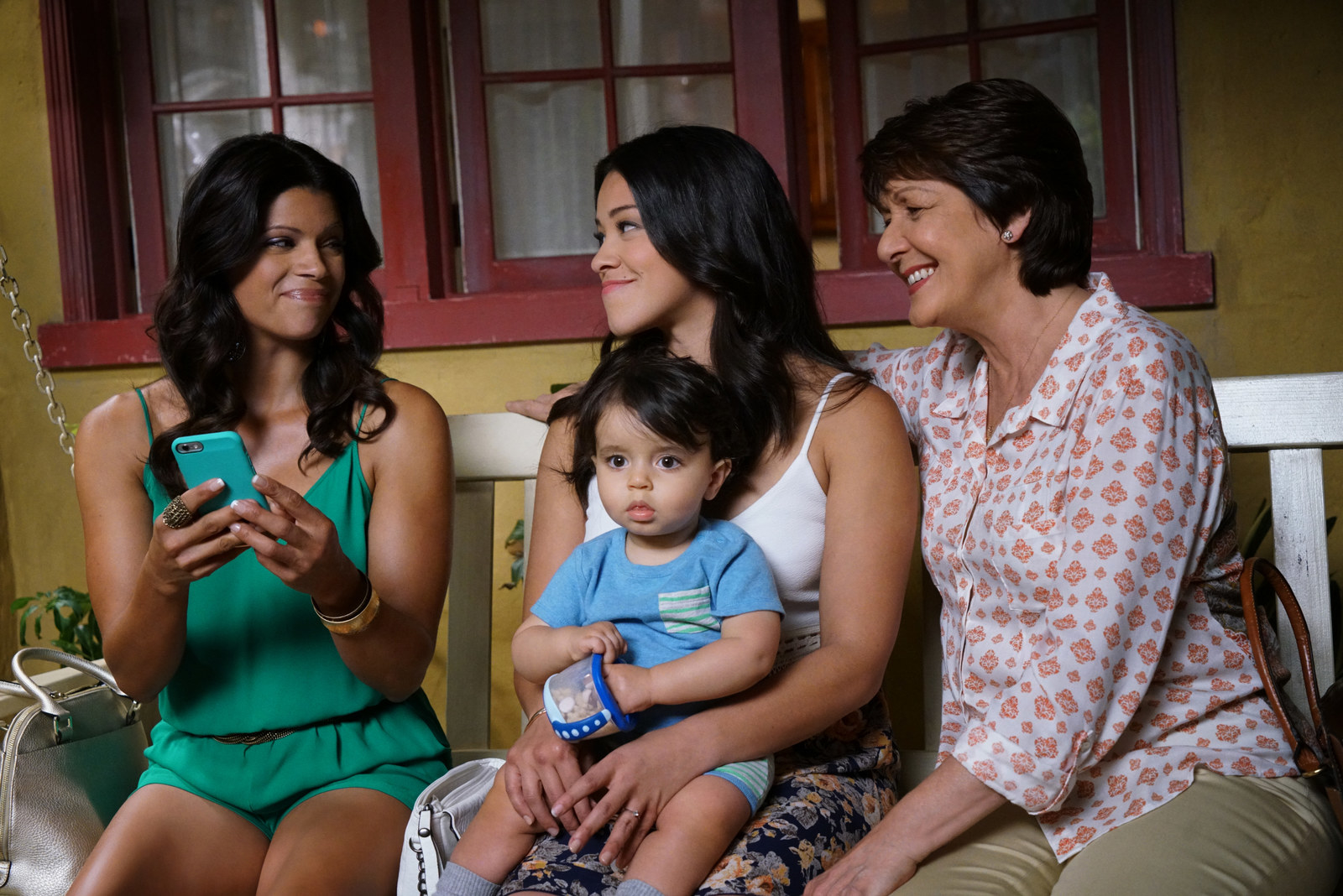
The original Charmed is not the only show influencing the new iteration. The show is, in many ways, also a creative descendant of Jane the Virgin, the beloved series that Urman created and which O’Toole and Rardin have been working on since its first season. At the Comic-Con panel, Urman cited her experience on Jane as showing her just how important it is to fight for representation in Hollywood — it was a big part of why an inclusive cast and writers room was important to them when building Charmed. It also left a big mark on the narrative.
“The intricacy of the storytelling of Jane the Virgin was such a master class,” O’Toole said. Jane the Virgin is a telenovela that straddles a lot of different genres and devices — it’s full of magical realism, comedy, and drama, and it wields each of them expertly. O’Toole said watching how Urman juggled all of those styles and tones as showrunner had a major impact on O’Toole and Rardin as showrunners on Charmed, especially since Charmed is also “a show you want to be really soapy, but also scary, and funny.”
The Jane the Virgin connection was just as important to Diaz. “I was really excited about Jennie being [a producer on Charmed], because of what Jane the Virgin did for me as a viewer, to see someone who looked like me, felt like me,” she said. “I knew they were the right people to take this show, and modernize it, and make it cool.”
